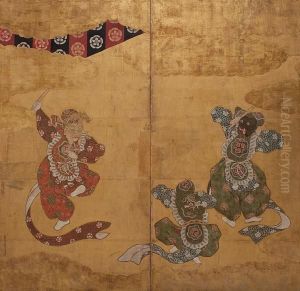Ogawa Haritsu Paintings
Ogawa Haritsu, also known as Ritsuo, was a prominent Japanese artist, craftsman, and scholar of the Edo period. Born in 1663 in Kyoto, Haritsu was a versatile artist who mastered various mediums and techniques, including lacquerware, ceramics, and metalwork. His work is often characterized by its intricate detail, innovative designs, and a fusion of traditional Japanese aesthetics with elements from Chinese and Korean art.
Haritsu began his artistic training under the tutelage of his father, who was a confectioner. This early experience with the craft of making sweets influenced his later work in lacquer and ceramics. He did not confine himself to the family trade, however, and he sought to learn from various craftsmen and artists of different fields. Haritsu is particularly noted for his revival of the neglected art of 'raku' ware, a type of Japanese pottery traditionally used in tea ceremonies.
In addition to his practical work, Haritsu was also a scholar of Chinese and Japanese classics, bringing a deep cultural and historical understanding to his art. He was well-versed in the philosophy of wabi-sabi, an aesthetic centered on the acceptance of transience and imperfection. This philosophy deeply influenced his work and contributed to the rustic and understated beauty that characterizes many of his pieces.
Haritsu's legacy extends beyond his own creations; he was also a teacher and a writer. He wrote 'Waza-bi no tomo' ('A Friend in the Arts'), which reflects on art and craftsmanship. Through his writings and his diverse body of work, he helped to bridge the gap between the fine arts and the crafts, which were traditionally seen as separate realms.
Ogawa Haritsu passed away in 1747, leaving behind a body of work that has had a lasting impact on Japanese art. His innovative approach to traditional materials and his blending of artistic disciplines have inspired many subsequent generations of artists. Haritsu's works can be found in numerous collections, both in Japan and internationally, and continue to be celebrated for their beauty and craftsmanship.
